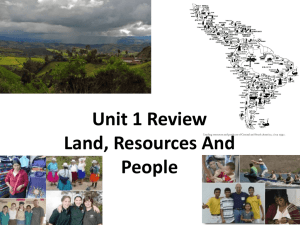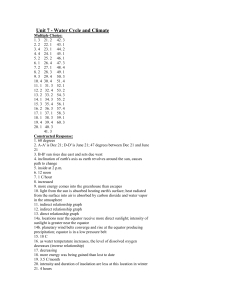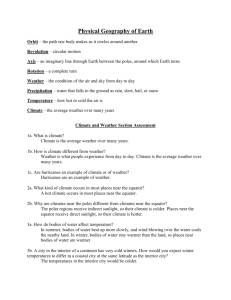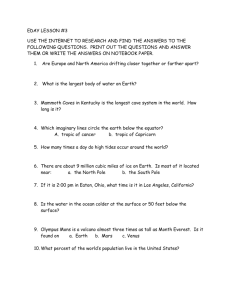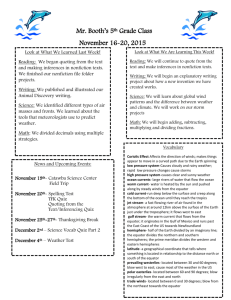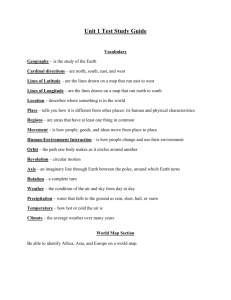Document
advertisement
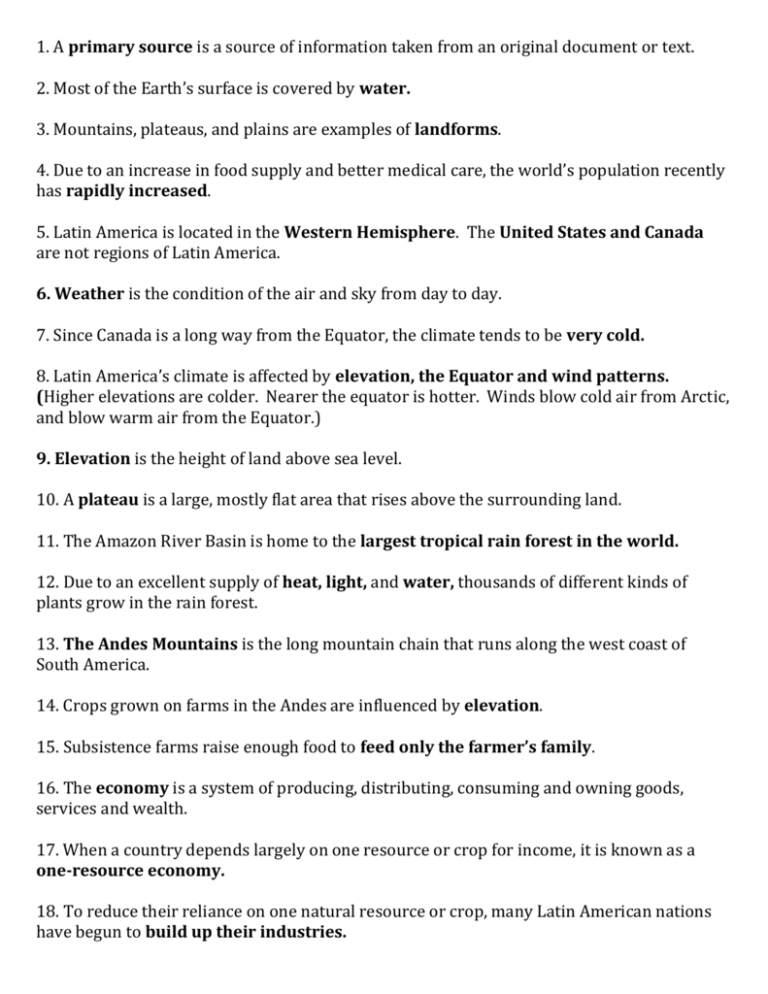
1. A primary source is a source of information taken from an original document or text. 2. Most of the Earth’s surface is covered by water. 3. Mountains, plateaus, and plains are examples of landforms. 4. Due to an increase in food supply and better medical care, the world’s population recently has rapidly increased. 5. Latin America is located in the Western Hemisphere. The United States and Canada are not regions of Latin America. 6. Weather is the condition of the air and sky from day to day. 7. Since Canada is a long way from the Equator, the climate tends to be very cold. 8. Latin America’s climate is affected by elevation, the Equator and wind patterns. (Higher elevations are colder. Nearer the equator is hotter. Winds blow cold air from Arctic, and blow warm air from the Equator.) 9. Elevation is the height of land above sea level. 10. A plateau is a large, mostly flat area that rises above the surrounding land. 11. The Amazon River Basin is home to the largest tropical rain forest in the world. 12. Due to an excellent supply of heat, light, and water, thousands of different kinds of plants grow in the rain forest. 13. The Andes Mountains is the long mountain chain that runs along the west coast of South America. 14. Crops grown on farms in the Andes are influenced by elevation. 15. Subsistence farms raise enough food to feed only the farmer’s family. 16. The economy is a system of producing, distributing, consuming and owning goods, services and wealth. 17. When a country depends largely on one resource or crop for income, it is known as a one-resource economy. 18. To reduce their reliance on one natural resource or crop, many Latin American nations have begun to build up their industries. 19. The drop in oil prices in the 1980s probably helped to convince Venezuela to promote investment in other industries, (diversify). 20. Fossil fuels are resources that were created over millions of years from the remains of prehistoric plants and animals. 21. Coal and natural gas are examples of nonrenewable resources. 22. Migration is the movement of people from one country or region to another. 23. Involuntary migration is when people are forced to move from one location to another. Demographers use the “push-pull” theory to explain reasons for immigration. Geographers use the “push-pull” theory to explain immigration. 24. Many people have moved from rural areas to urban areas (cities). They did this to want to give their children more opportunities, (health care, education, better paying jobs). 25. Many people leave the rural, country living for the urban, city life in hopes of finding jobs. 26. Urban – located in cities and towns Essay Questions: The following are the four essay questions which will appear on the test. Students will choose two to answer. Use this time to start preparing an answer. 1. What is the difference between weather and climate? Identify three factors that effect climate. (See 7 and 8 above fro some suggestions, but not all of this answer) 2. Support or refute (disprove, prove false) this conclusion: South America is a region of great variety and many contrasts. 3. Why has relying on one crop or resource presented an economic problem for many Latin American nations? How have these nations been trying to solve this problem? 4. How does the push-pull theory explain immigration? Give two examples of each. Push-Pull Theory – When people living in a region find it difficult to live, they feel a push to move away in search of better paying jobs or better schools and medical care. The hope for better living conditions pulls them to a new location. This is often rural to urban setting. 5. How are people influenced by their environment? Give an example. Climate Regions: The test will have a similar map of a country of South America. Students will need to use the Key, which indicates the climate regions for that country. They will answer the following questions based on the map and key. For this review, I have substituted the test’s country with South America. 1. Which climate region covers the most territory in South America? 2. In what climate zone is X city located? (The test’s map will have cities labeled) 3. What is the climate around the Equator? (There should be more than one choice.) 4. Where do you think it is generally colder, in northern South America or southern South America? Why?
